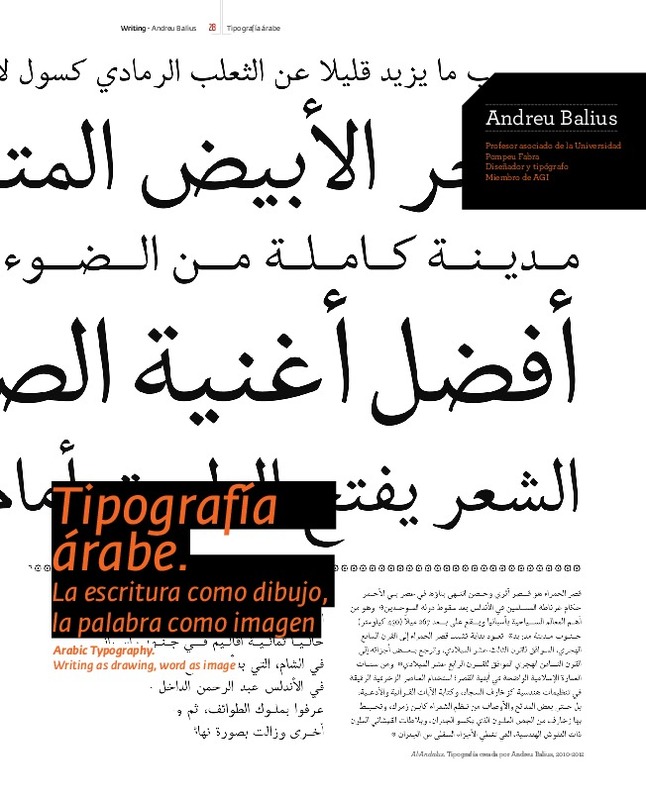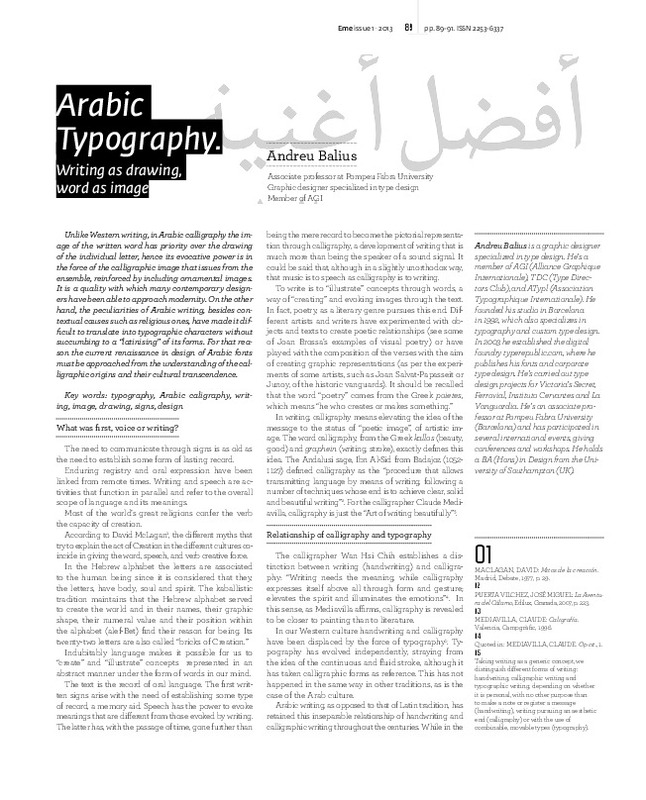JavaScript is disabled for your browser. Some features of this site may not work without it.
Buscar en RiuNet
Listar
Mi cuenta
Estadísticas
Ayuda RiuNet
Admin. UPV
Tipografía árabe. La escritura como dibujo, la palabra como imagen
Mostrar el registro sencillo del ítem
Ficheros en el ítem
| dc.contributor.author | Balius, Andreu
|
es_ES |
| dc.date.accessioned | 2017-01-13T13:36:15Z | |
| dc.date.available | 2017-01-13T13:36:15Z | |
| dc.date.issued | 2013-10-28 | |
| dc.identifier.issn | 2253-6337 | |
| dc.identifier.uri | http://hdl.handle.net/10251/76772 | |
| dc.description.abstract | [EN] Unlike Western writing, in Arabic calligraphy the im-age of the written word has priority over the drawing of the individual letter, hence its evocative power is in the force of the calligraphic image that issues from the ensemble, reinforced by including ornamental images. It is a quality with which many contemporary design-ers have been able to approach modernity. On the other hand, the peculiarities of Arabic writing, besides con-textual causes such as religious ones, have made it dif-ficult to translate into typographic characters without succumbing to a “latinising” of its forms. For that rea-son the current renaissance in design of Arabic fonts must be approached from the understanding of the cal-ligraphic origins and their cultural transcendence | es_ES |
| dc.description.abstract | [ES] A diferencia de la escritura occidental, en la caligrafía árabe la imagen de la palabra escrita tiene prioridad sobre el dibujo individual de cada letra, así su poder evocador está en la fuerza de la imagen caligráfica que desprende el conjunto, reforzada por la incorporación de imágenes ornamentales. Una cualidad que muchos diseñadores contemporáneos han sabido acercar a la modernidad. De otro lado, las particularidades de la escritura árabe, además de causas contextuales como las religiosas, han hecho difícil componer textos sin caer en una “latinización” de formas. Por ello, el actual renacer del diseño de fuentes árabes debe hacerse desde el entendimiento de las bases caligráficas y su transcendencia cultural | es_ES |
| dc.language | Español | es_ES |
| dc.language | Inglés | es_ES |
| dc.publisher | Universitat Politècnica de València | |
| dc.relation.ispartof | EME Experimental Illustration, Art & Design | |
| dc.rights | Reconocimiento - No comercial (by-nc) | es_ES |
| dc.subject | Typography | es_ES |
| dc.subject | Writing | es_ES |
| dc.subject | Image | es_ES |
| dc.subject | Drawing | es_ES |
| dc.subject | Signs | es_ES |
| dc.subject | Design | es_ES |
| dc.subject | Arabic calligraphy | es_ES |
| dc.subject | Caligrafía árabe | es_ES |
| dc.subject | Tipografía | es_ES |
| dc.subject | Escritura | es_ES |
| dc.subject | Imagen | es_ES |
| dc.subject | Dibujo | es_ES |
| dc.subject | Signos | es_ES |
| dc.subject | Diseño | es_ES |
| dc.title | Tipografía árabe. La escritura como dibujo, la palabra como imagen | es_ES |
| dc.title.alternative | Arabic Typography. Writing as drawing, word as image | es_ES |
| dc.type | Artículo | es_ES |
| dc.date.updated | 2017-01-13T11:24:21Z | |
| dc.identifier.doi | 10.4995/eme.2012.1774 | |
| dc.rights.accessRights | Abierto | es_ES |
| dc.description.bibliographicCitation | Balius, A. (2013). Tipografía árabe. La escritura como dibujo, la palabra como imagen. EME Experimental Illustration, Art & Design. (1):28-35. https://doi.org/10.4995/eme.2012.1774 | es_ES |
| dc.description.accrualMethod | SWORD | es_ES |
| dc.relation.publisherversion | https://doi.org/10.4995/eme.2012.1774 | es_ES |
| dc.description.upvformatpinicio | 28 | es_ES |
| dc.description.upvformatpfin | 35 | es_ES |
| dc.type.version | info:eu-repo/semantics/publishedVersion | es_ES |
| dc.description.issue | 1 | |
| dc.identifier.eissn | 2341-3018 | |
| dc.description.references | BLAIR, Sheila S.: Islamic calligraphy, Edinburgh: Edinburgh University Press, 2008. | es_ES |
| dc.description.references | BOUTROS, Mourad ET al.: Talking about Arabic, New York, Mark Batty publisher, 2009. | es_ES |
| dc.description.references | SAFADI, Yasin Hamid : Islamic calligraphy, London, Thames & Hudson, 1978. | es_ES |









